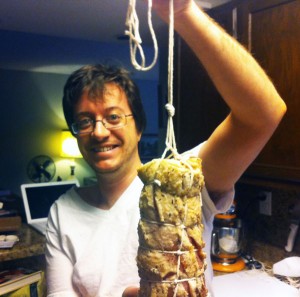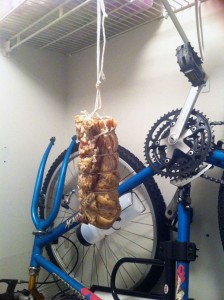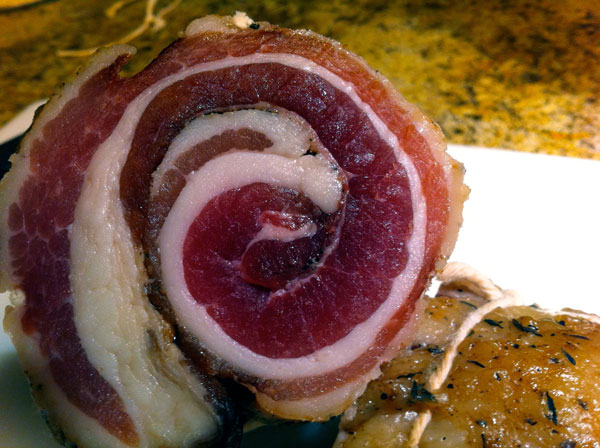Everybody loves cured meats. (Okay, not vegetarians, but nobody ever gave up animal protein because they hate bacon.) Unfortunately, nobody knows how to make them themselves anymore. The grand traditions of at-home salting, smoking, and drying are long dead.
Fortunately, there’s Michael Ruhlman to bring back DIY cooking of all kinds. I love his book Charcuterie (aff. link): It’s filled with delicious and well-explained recipes for everything from bratwurst and hot dogs to salami and duck confit.
Way back when I was an editorial intern at CHOW, I got to write the introduction for a story about making your own pancetta that used Ruhlman’s recipe. I didn’t actually participate in the pork-belly-curing itself, but my interest was certainly piqued. Three years later, when a friend of mine raised and killed two pigs (that’s another story), we used Charcuterie extensively.
That was the first time I ever made pancetta; it came out pretty well, though I wasn’t completely thrilled. This year, my CSA farm raised a few pigs and offered them to its members. I went in with a couple friends on half of one and knew I wanted to try this recipe again.
Making your own pancetta is really not hard. It requires a few obscure ingredients, but they can all be ordered online or requested at your local grocery store. It also takes three weeks from start to finish, but you don’t have to do anything to it for most of that time.
One ingredient you almost definitely don’t have on hand for pancetta is pink salt. Also called insta-cure #1, it’s a mixture of regular table salt (sodium chloride) and a small amount of sodium nitrite. The nitrite prevents bacterial growth and preserves meat’s red color, making it absolutely indispensible for cured meats of all kinds. (Pink salt is dyed bright pink so you don’t confuse it with regular salt—sodium nitrite is poisonous in large doses.) Luckily, pink salt is cheap: a pound (enough to make about three dozen pancettas) costs six bucks on Amazon (aff. link).

You’ll also need pork belly, the fatty slab of meat that’s also made into bacon (pancetta is essentially unsmoked bacon). This is probably something you’ll have to special order from the butcher counter at your local grocery store. Ask for a five-pound slab, preferably with the skin already removed. (Cutting the skin off requires some time and a very, very sharp knife.) Basically, you need half of a whole pork belly. (Ironically enough, what butchers call a “whole pork belly” is usually one half of the pig’s entire belly.)
The hardest part of making pancetta (besides getting over your impatience while it’s curing) is tying it. CHOW‘s video on how to do so makes it look easy, but nothing ever works as beautifully as it does through the magic of TV. Make sure you roll the belly up extremely tightly, and you may want to brush up on your butcher’s knot before attempting the process. In the end, your tied pancetta doesn’t have to look pretty; it just has to be rolled tightly and securely.
Because it’s not meant to be eaten raw, pancetta is a little more forgiving than dry-cured meats like salami or pepperoni. It’s a good introduction to the process.
Pancetta
(adapted from Charcuterie: The Craft of Salting, Smoking, and Curing by Michael Ruhlman and Brian Polcyn)
4 cloves garlic, minced
2 tsp. pink salt
1/4 cup kosher salt
2 tbsp. brown sugar
2 tbsp. juniper berries, lightly crushed with a heavy pan or the side of a knife
4 bay leaves, crumbled
1 tsp. grated nutmeg
1 tbsp. dried thyme
4 tbsp. coarsely ground black pepper, divided
1 (5-pound) slab pork belly
Stir together garlic, salts, sugar, juniper, bay leaves, nutmeg, thyme, and 2 tbsp. pepper in a bowl. Remove skin from pork belly if necessary and trim into a neat rectangle with square corners. (You can cook the trimmings with a pot of beans or collard greens.)
 Rub spice mixture over all sides of pork belly so it is uniformly coated. Place belly in a zip-top bag large enough that it can lay flat, or place in a container large enough to hold it flat (I used a lasagna pan) and cover with plastic wrap. Refrigerate for 7 days, flipping belly over every other day.
Rub spice mixture over all sides of pork belly so it is uniformly coated. Place belly in a zip-top bag large enough that it can lay flat, or place in a container large enough to hold it flat (I used a lasagna pan) and cover with plastic wrap. Refrigerate for 7 days, flipping belly over every other day.
After 7 days, feel the belly to determine if it’s finished curing. It should be firm at its thickest point. If it still feels squishy like raw meat, refrigerate for 1 to 2 more days.

Once belly is fully cured, rinse thoroughly under cold water to remove as much spice mixture as possible. Pat dry and lay on a cutting board meat-side-up. Sprinkle meat side with remaining 2 tbsp. pepper. Roll belly very tightly into a cylindrical shape (you don’t want any air inside the rolled-up meat) and tie securely with butcher’s twine at 1- to 2-inch intervals.
Hang pancetta in a cool, relatively humid place for two weeks. (I used a spare closet that gets used about as much as that bike in the photo.) Pancetta will dry out and become leathery, but should not become hard and lose its pliability. (If it starts to dry out too much, take it down, wrap in plastic, and refrigerate. Use within 2 to 3 weeks.)
Once pancetta has dried, wrap in plastic and refrigerate up to 3 weeks or freeze up to 4 months.
So now that you have 4 pounds of pancetta, what are you supposed to do with it? Sliced thin, it can be cooked like bacon for breakfast or used to top a pizza. Cooked with onion, tomato, pecorino and red pepper, it becomes the sugo all’amatriciana, a wonderfully spicy sauce for pasta. And then there’s my favorite—carbonara, the creamy pasta sauce made with pancetta, Parmesan, and eggs. Look for a carbonara post here very soon.

where did you get your belly? i’m looking in to doing some bacon.
I got my belly from Sequatchie Cove, a farm in TN that sells pork, beef, and lamb at Pepper Place. You can get an uncured belly from basically anybody that sells pork; you just have to special-order it, and that may take a week or so. My advice would be to order yours with the skin already removed—cutting off the skin is a huge pain.